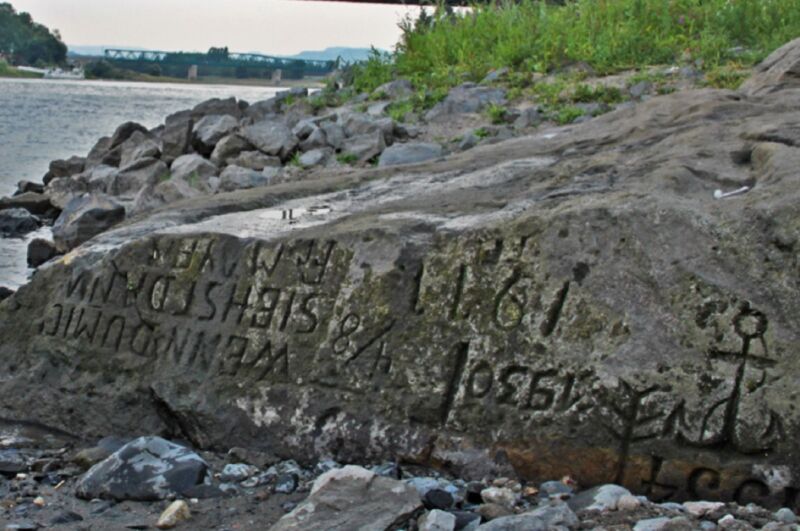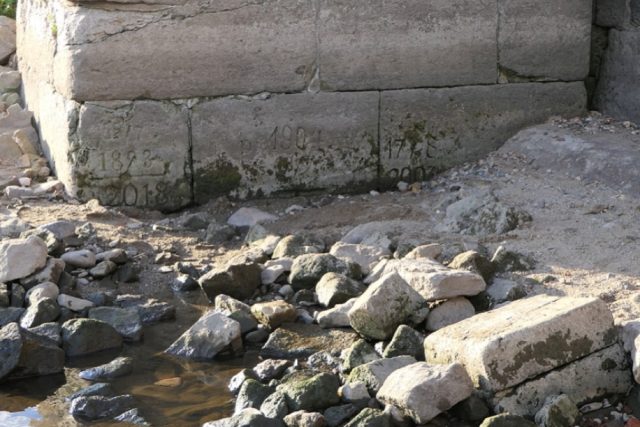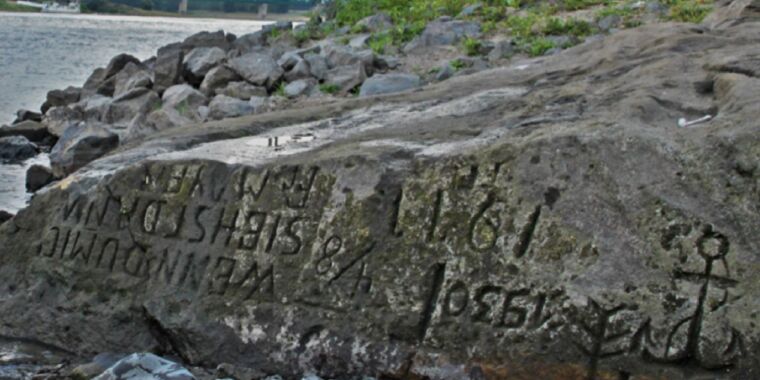
Stories have been circling around the Internet this past week about the re-emergence in certain Czech and German rivers of so-called “hunger stones“—rocks embedded in rivers during droughts to mark the water level and warn future generations of the likely famine and hardship to come whenever the stones became visible again. The coverage has been fueled largely by an August 11 tweet noting one stone in particular, inscribed with a dire warning: “If you see me, weep.”
Hunger stones (hungerstein) are very much a real thing with a long and fascinating history. And Europe is in the midst of a historically severe drought—severe enough that water levels may indeed be sufficiently low for the stones to re-emerge once more. But that August 11 tweet and the related coverage are actually rehashing a series of news stories from 2018, when the re-emergence of the hunger stones in the midst of that year’s extreme drought in Europe made headlines.
It’s hardly an egregious case of misinformation, but it does provide an illustrative example of why including context is so important in the digital age—even in a relatively simple tweet enthusing about newly acquired knowledge.
The recent droughts in Europe once again made visible the “Hunger Stones” in some Czech and German rivers. These stones were used to mark desperately low river levels that would forecast famines.
This one, in the Elbe river, is from 1616 and says: “If you see me, cry” pic.twitter.com/uJTapWXN5y
— Shoko Asahara Appreciation Consortium 🇷🇼 (@Citizen09372364) August 11, 2022
The stone referenced in the August 11 tweet is located on the Elbe River in Děčín, Czech Republic—one of the oldest such landmarks in the region. The earliest readable inscribed date is 1616, but older carvings marking the droughts of 1417 and 1473 were wiped out by anchoring ships over the centuries. Other drought years carved in the stone include 1707, 1746, 1790, 1800, 1811, 1830, 1842, 1868, 1892, and 1893. It’s actually possible to see this particular stone some 126 days out of the year, thanks to the construction of a dam that was built on a tributary of the Elbe in 1926.
The stone also features an inscription likely added in 1938: “Neplač holka, nenaříkej, když je sucho, pole stříkej” (“Girl, don’t weep and moan, if it’s dry, water the field”). Another Elbe stone can be found near Bleckede, with the inscription Geht dieser Stein unter, wird das Leben wieder bunter (“When this stone goes under, life will become more colorful again”).
A 2013 paper examining the history of drought in the Czech region from 1090 to 2012 relied in part on hunger stones as “epigraphic data” of past droughts, supplementing evidence gleaned from annals, chronicles, diaries, tax documents, religious records, letters, printed manuscripts, and modern instrumental data. (Apparently in 1393, the drought was so severe it was possible to cross the River Vltava on its bed, and the water was “as green as grass.”)
Frankly, that paper is worth reading just for the historical anecdote concerning a priest named Prokop Diviš, known for serendipitously constructing one of the earliest grounded lightning rods. Diviš set up his “weather instrument” at his parsonage in June 1754. It was composed of several tin boxes and more than 400 metal spikes, and Diviš thought it could drive off storms. (The scientific community at the time was less than impressed with his theories.)
Five years later, in the fall of 1759, local villagers demanded Diviš remove it, convinced that it had been the cause of that summer’s drought. The authors suggest the priest’s personal enemies had riled up the crowd. The following March, the villagers broke the chains holding the instrument down, and a thunderstorm the following night knocked it over. But their victory was short-lived. There were so many thunderstorms that summer, damaging the fields and vineyards, that the villagers asked him to re-install his weather instrument. “His response was not positive,” the authors wrote.

Dr. Bernd Gross/CC BY-SA 3.0
When Central Europe was yet again besieged by drought in 2018, the Elbe plummeted to its lowest levels in more than half a century, and news stories began circulating about the re-emergence of some of the hunger stones. The Associated Press, NPR, Smithsonian, and Atlas Obscura were among the outlets that covered the story.
So why has the story re-emerged now? Kim LaCapria, writing at Truth or Fiction, thinks it started with an August 10 post to the subreddit r/todayilearned, linking to the Wikipedia entry on hunger stones “simply as a point of interest.” Perhaps not coincidentally, two days before that, low-water levels in Lake Mead due to the extreme megadrought resulted in the discovery of yet another set of human remains—the fourth body found so far. So, as conversations about drought and climate change circulated in the ether, they created the perfect conditions to reignite interest in the hunger stones, sparking a fresh flurry of news stories—like this one.








